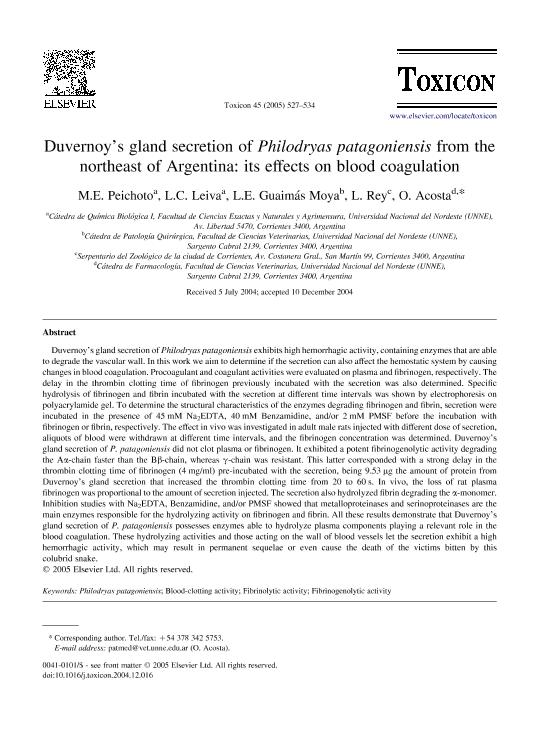Mostrar el registro sencillo del ítem
dc.contributor.author
Peichoto, María Elisa

dc.contributor.author
Leiva, Laura Cristina Ana

dc.contributor.author
Guaimás Moya, L. E.
dc.contributor.author
Rey, L.
dc.contributor.author
Acosta, Ofelia Cristina

dc.date.available
2018-07-13T13:47:00Z
dc.date.issued
2005-03
dc.identifier.citation
Peichoto, María Elisa; Leiva, Laura Cristina Ana; Guaimás Moya, L. E.; Rey, L.; Acosta, Ofelia Cristina; Duvernoy's gland secretion of Philodryas patagoniensis from the northeast of Argentina: Its effects on blood coagulation; Pergamon-Elsevier Science Ltd; Toxicon; 45; 4; 3-2005; 527-534
dc.identifier.issn
0041-0101
dc.identifier.uri
http://hdl.handle.net/11336/51986
dc.description.abstract
Duvernoy's gland secretion of Philodryas patagoniensis exhibits high hemorrhagic activity, containing enzymes that are able to degrade the vascular wall. In this work we aim to determine if the secretion can also affect the hemostatic system by causing changes in blood coagulation. Procoagulant and coagulant activities were evaluated on plasma and fibrinogen, respectively. The delay in the thrombin clotting time of fibrinogen previously incubated with the secretion was also determined. Specific hydrolysis of fibrinogen and fibrin incubated with the secretion at different time intervals was shown by electrophoresis on polyacrylamide gel. To determine the structural characteristics of the enzymes degrading fibrinogen and fibrin, secretion were incubated in the presence of 45 mM Na2EDTA, 40 mM Benzamidine, and/or 2 mM PMSF before the incubation with fibrinogen or fibrin, respectively. The effect in vivo was investigated in adult male rats injected with different dose of secretion, aliquots of blood were withdrawn at different time intervals, and the fibrinogen concentration was determined. Duvernoy's gland secretion of P. patagoniensis did not clot plasma or fibrinogen. It exhibited a potent fibrinogenolytic activity degrading the Aα-chain faster than the Bβ-chain, whereas γ-chain was resistant. This latter corresponded with a strong delay in the thrombin clotting time of fibrinogen (4 mg/ml) pre-incubated with the secretion, being 9.53 μg the amount of protein from Duvernoy's gland secretion that increased the thrombin clotting time from 20 to 60 s. In vivo, the loss of rat plasma fibrinogen was proportional to the amount of secretion injected. The secretion also hydrolyzed fibrin degrading the α-monomer. Inhibition studies with Na2EDTA, Benzamidine, and/or PMSF showed that metalloproteinases and serinoproteinases are the main enzymes responsible for the hydrolyzing activity on fibrinogen and fibrin. All these results demonstrate that Duvernoy's gland secretion of P. patagoniensis possesses enzymes able to hydrolyze plasma components playing a relevant role in the blood coagulation. These hydrolyzing activities and those acting on the wall of blood vessels let the secretion exhibit a high hemorrhagic activity, which may result in permanent sequelae or even cause the death of the victims bitten by this colubrid snake.
dc.format
application/pdf
dc.language.iso
eng
dc.publisher
Pergamon-Elsevier Science Ltd

dc.rights
info:eu-repo/semantics/openAccess
dc.rights.uri
https://creativecommons.org/licenses/by-nc-sa/2.5/ar/
dc.subject
Blood-Clotting Activity
dc.subject
Fibrinogenolytic Activity
dc.subject
Fibrinolytic Activity
dc.subject
Philodryas Patagoniensis
dc.subject.classification
Sistema Respiratorio

dc.subject.classification
Medicina Clínica

dc.subject.classification
CIENCIAS MÉDICAS Y DE LA SALUD

dc.title
Duvernoy's gland secretion of Philodryas patagoniensis from the northeast of Argentina: Its effects on blood coagulation
dc.type
info:eu-repo/semantics/article
dc.type
info:ar-repo/semantics/artículo
dc.type
info:eu-repo/semantics/publishedVersion
dc.date.updated
2018-06-07T17:54:54Z
dc.journal.volume
45
dc.journal.number
4
dc.journal.pagination
527-534
dc.journal.pais
Estados Unidos

dc.description.fil
Fil: Peichoto, María Elisa. Consejo Nacional de Investigaciones Científicas y Técnicas. Centro Científico Tecnológico Conicet - Nordeste; Argentina. Universidad Nacional del Nordeste. Facultad de Ciencias Exactas y Naturales y Agrimensura; Argentina
dc.description.fil
Fil: Leiva, Laura Cristina Ana. Consejo Nacional de Investigaciones Científicas y Técnicas. Centro Científico Tecnológico Conicet - Nordeste; Argentina. Universidad Nacional del Nordeste. Facultad de Ciencias Exactas y Naturales y Agrimensura; Argentina
dc.description.fil
Fil: Guaimás Moya, L. E.. Universidad Nacional del Nordeste. Facultad de Ciencias Veterinarias; Argentina
dc.description.fil
Fil: Rey, L.. Serpentario del Zoológico de la Ciudad de Corrientes; Argentina
dc.description.fil
Fil: Acosta, Ofelia Cristina. Consejo Nacional de Investigaciones Científicas y Técnicas. Centro Científico Tecnológico Conicet - Nordeste; Argentina. Universidad Nacional del Nordeste. Facultad de Ciencias Veterinarias; Argentina
dc.journal.title
Toxicon

dc.relation.alternativeid
info:eu-repo/semantics/altIdentifier/url/https://www.sciencedirect.com/science/article/pii/S0041010104005124
dc.relation.alternativeid
info:eu-repo/semantics/altIdentifier/doi/http://dx.doi.org/10.1016/j.toxicon.2004.12.016
Archivos asociados
